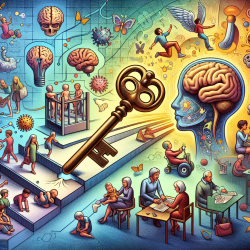Understanding the Link Between Brain Structure and Cognitive Abilities
As practitioners in the field of speech-language pathology, we are constantly seeking ways to enhance the cognitive and communicative outcomes for children. Recent research offers intriguing insights into how the structure of the brain, particularly subcortical volumes, correlates with cognitive measures. This understanding can guide us in tailoring interventions that are more effective and data-driven.
The Research Behind the Insights
The study titled Predictive models demonstrate age-dependent association of subcortical volumes and cognitive measures by Weerasekera et al. (2023) delves into the relationship between brain structure and cognitive functioning. The researchers analyzed data from 193 healthy individuals, both young and older adults, as part of the Leipzig Study for Mind-Body-Emotion Interactions (LEMON). Using machine learning models, they explored how different brain regions predict various cognitive abilities, such as fluid intelligence, crystallized intelligence, cognitive flexibility, and working memory.
Key Findings and Their Implications
The study found significant age-dependent associations between subcortical brain volumes and cognitive measures. Here are some key takeaways:
- Fluid Intelligence: Cortical white matter was a critical predictor for both young and older adults.
- Crystallized Intelligence: For young adults, volumes of the caudate nucleus, thalamus, pallidum, and nucleus accumbens were important, whereas for older adults, the putamen, amygdala, nucleus accumbens, and hippocampus played significant roles.
- Cognitive Flexibility: In young adults, the caudate, nucleus accumbens, and hippocampus were key, while in older adults, the caudate and amygdala were crucial.
- Working Memory: The putamen, pallidum, and nucleus accumbens were significant for younger individuals, with the amygdala and hippocampus being predictive for older adults.
These findings suggest that different brain structures contribute to cognitive abilities in an age-dependent manner. For practitioners, this means that interventions could be more effective if they are tailored to target specific brain regions based on the age of the individual.
Practical Applications for Practitioners
Understanding these associations can significantly impact how we approach therapy and interventions. Here are some practical applications:
- Customized Interventions: By focusing on specific brain regions, we can design interventions that are more likely to improve targeted cognitive skills.
- Age-Specific Strategies: Recognizing that different ages require different approaches can help us refine our strategies to better support cognitive development.
- Predictive Assessments: Using predictive models, we can assess the likelihood of cognitive decline or improvement, allowing for proactive interventions.
Encouraging Further Research
While this study provides valuable insights, it also opens the door for further research. As practitioners, staying informed about ongoing research and contributing to it can enhance our understanding and effectiveness. Exploring how these findings can be applied to diverse populations, including children with developmental disorders, could be particularly beneficial.
To read the original research paper, please follow this link: Predictive models demonstrate age-dependent association of subcortical volumes and cognitive measures.










